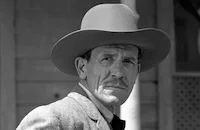Tramp, Tramp, Tramp
Cast & Crew
Charles Barton
Jackie Gleason
Jack Durant
Florence Rice
Bruce Bennett
Hallene Hill
Film Details
Technical Specs

Synopsis
When the draft depletes the male population of the town of Bellville, barbers Hank Tomlin and Jed Hart decide to follow their clients to Camp Horton. After they are rejected as physically unfit for military service, the two barbers hitchhike back to town and are offered a ride by Tommy Lydel, a former customer who is now serving in the army. Upon hearing their tale of woe, Tommy suggests that they move into his grandmother's house. There, inspired by Granny's tales of patriotism, Hank and Jed decide to serve their country by starting a "home defense" army. Recruiting their troops from the rejects of the draft board, the pair assemble a small military camp in Granny's backyard. Seven weeks later, Hank's sweetheart Vivian returns from visiting her aunt and demands that Hank terminate their nine-year courtship and marry her. After the couple is wed, Vivian is appointed head of the camp's First Aid station. Pam Martin, Tommy's reporter girl friend, decides to write a story about the camp for her newspaper, and soon Home Defense armies are established throughout the country. When Biggie Waldron, the leader of a gang of fugitives fleeing a murder charge, reads Pam's article, he decides that the Bellville camp presents the perfect refuge from their pursuers. Soon after, Biggie, Blond Bomber, Mousey, Blackie amd Lefty arrive at the camp and enlist as the "Smith" brothers. There, Blondie begins to flirt with Vivian, and consequently, when Hank is separated from his wife at a movie theater, he suspects that she may have left with the new recruit. Searching for Vivian, Hank sneaks around the back of the tent in which the fugitives are housed and overhears them discussing their crimes. Alarmed, he runs into the house and blurts out the information to Pam. When Pam suggests sending pictures of the gang to her newspaper so that they can be positively identified, Hank dreams up a way to surreptiously photograph them. The next day, Hank visits their tent, and feigning an interest in promoting them to officers, he secretly snaps pictures with several tiny cameras that he has concealed in his clothes. Soon after, the paper calls Pam with confirmation of the felons' identities and news that the police are on their way to the camp. Hank then proceeds to the First Aid tent to warn Vivian. There, Blondie overhears their conversation and notifies Biggie and the others about their impending peril. As the criminals plot their escape, Hank leads his troops to surround the tent. After ordering the men to wait until he says the password to converge on the tent, Hank walks inside. When he forgets the password, the gang takes him hostage, until one of the criminals inadvertently says the password and the soldiers pull the stakes from under the tent, causing it to collapse. As Hank's troops batter the criminals with baseball bats, the police arrive to take them to jail, and Hank, although bruised in the mêlée, has the satisfaction of a job well done.

Director
Charles Barton
Cast

Jackie Gleason
Jack Durant

Florence Rice

Bruce Bennett
Hallene Hill

Billy Curtis
Mabel Todd

Forrest Tucker
James Seay
John Tyrrell
John Harmon
Eddie Foster
Al Hill
Borrah Minevitch
Heinie Conklin

Kenneth Macdonald

Eddie Kane
William Gould
Chuck Morrison
Herbert Rawlinson
Bud Jamison
Glenn Turnbull

James Millican
John Dilson

Walter Sande
Bud Geary
Harry Strang
George Turner

Lloyd Bridges
Eddie Laughton
Crew
Lionel Banks
Hal Braham
Irving Briskin
Ned Dandy
Shannon Day
Jack Goodrich
Marian Grant
William Lyon
Wallace Macdonald
Harry Rebuas
George Rhein
Arthur Royce
John Stumar

Film Details
Technical Specs

Quotes
Trivia
Notes
The working title of this film was Camp Nuts. Several reviews commented that the characters portrayed by Jackie Gleason and Jack Durant were patterned after popular radio comedians Bud Abbott and Lou Costello. The picture was refused an export license by the Office of Censorship of the Los Angeles Board of Review, according to materials contained in the National Archive in Washington, D.C. This title was previously used by Columbia in 1926 for a Frank Capra-directed film starring Harry Langdon, but the stories are otherwise unrelated (see AFI Catalog of Feature Films, 1921-30; F2.5824).












